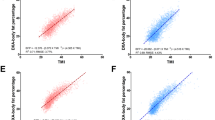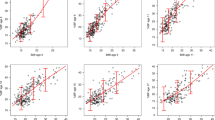Abstract
OBJECTIVES: To explore a new anthropometric index of body fat distribution adjusted for ages ranging from 6–15 y in both boys and girls. DESIGN: Sex, age, and 11 anthropometric variables were subjected to principal component analysis. Based on these results, we developed a new anthropometric index, namely an age-adjusted measure of body fat distribution. This index was evaluated statistically for suitability of use in epidemiological surveys. SUBJECTS: Japanese children, including obese and nonobese subjects, in one elementary and one junior high school in Yamanashi Prefecture, Japan: 508 boys and 549 girls whose ages ranged from 6 y 1 mon–15 y. MEASUREMENTS: Measurements included the height (Ht), body weight, circumference of the waist, hip and thigh. Body mass index, the ratios of the waist, hip or thigh to the Ht, waist-hip ratio (WHR) and waist-thigh ratio were calculated. RESULTS: The first principal component (PC 1) accounted for 49.8% of the total variation, and was interpreted as an indicator of the general size of an individual. PC 2 accounted for 25.9%, and was interpreted as a shape measure that indicates body fat distribution. Calculation of WHR/Ht, a parameter that represented PC 2 adjusted by PC 1, gave an highly robust linear regression equation for age by gender. The residuals from the regression line for WHR/Ht deviated from normal distribution only in the boys, whereas the mean residual was nearly zero and distribution of the residuals was similar in three age subgroups by gender, supporting the use of the common standard deviation score in all age groups as an indicator of body fat distribution. CONCLUSION: The common standard deviation score of WHR/Ht can serve as an epidemiological index of body fat distribution adjusted for ages between 6 and 15 y.
This is a preview of subscription content, access via your institution
Access options
Subscribe to this journal
Receive 12 print issues and online access
$259.00 per year
only $21.58 per issue
Buy this article
- Purchase on Springer Link
- Instant access to full article PDF
Prices may be subject to local taxes which are calculated during checkout
Similar content being viewed by others
Author information
Authors and Affiliations
Rights and permissions
About this article
Cite this article
Asayama, K., Hayashi, K., Kawada, Y. et al. New age-adjusted measure of body fat distribution in children and adolescents: standardization of waist-hip ratio using multivariate analysis. Int J Obes 21, 594–599 (1997). https://doi.org/10.1038/sj.ijo.0800447
Received:
Revised:
Accepted:
Issue Date:
DOI: https://doi.org/10.1038/sj.ijo.0800447
Keywords
This article is cited by
-
Metabolic Syndrome in Overweight and Obese Japanese Children
Obesity Research (2005)
-
Increased Serum Cholesteryl Ester Transfer Protein in Obese Children
Obesity Research (2002)
-
Critical value for the index of body fat distribution based on waist and hip circumferences and stature in obese girls
International Journal of Obesity (2000)



